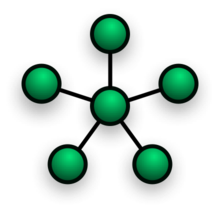අරීය ජාල
ජාල ස්ථල විද්යාව
[සංස්කරණය]ජාල තුල පරිගණක සම්බන්ඩතාව සැලසුම් කිරීම සහ ජාල ගත කිරීම ජාල ස්ථල විද්යාව (Network Topology) නම් වේ.
තරුවක් ආකාරයට ජාල ගත කිරීම (Star Topology)
[සංස්කරණය]මෙය සාමාන්යයෙන් දැකියහැකි ජාලයකි. නාබිය හෝ ස්විචය කේන්ද්ර කොටගෙන එයට පරිගණක සම්බන්ද කරනුලැබයි.

Star networks are one of the most common computer network topologies. In its simplest form, a star network consists of one central switch, hub or computer, which acts as a conduit to transmit messages. This consists of a central node, to which all other nodes are connected; this central node provides a common connection point for all nodes through a hub. In Star topology every node (computer workstation or any other peripheral) is connected to central node called hub or switch. The switch is the server and the peripherals are the clients.[1] Thus, the hub and leaf nodes, and the transmission lines between them, form a graph with the topology of a star. If the central node is passive, the originating node must be able to tolerate the reception of an echo of its own transmission, delayed by the two-way transmission time (i.e. to and from the central node) plus any delay generated in the central node. An active star network has an active central node that usually has the means to prevent echo-related problems.
The star topology reduces the chance of network failure by connecting all of the systems to a central node.[further explanation needed] When applied to a bus-based network, this central hub rebroadcasts all transmissions received from any peripheral node to all peripheral nodes on the network, sometimes including the originating node. All peripheral nodes may thus communicate with all others by transmitting to, and receiving from, the central node only. The failure of a transmission line linking any peripheral node to the central node will result in the isolation of that peripheral node from all others, but the rest of the systems will be unaffected.[2]
It is also designed with each node (file servers, workstations, and peripherals) connected directly to a central network hub, switch, or concentrator.
Data on a star network passes through the hub, switch, or concentrator before continuing to its destination. The hub, switch, or concentrator manages and controls all functions of the network. It also acts as a repeater for the data flow. This configuration is common with twisted pair cable. However, it can also be used with coaxial cable or optical fibre cable.
වාසි
[සංස්කරණය]• Better performance: star topology prevents the passing of data packets through an excessive number of nodes. At most, 3 devices and 2 links are involved in any communication between any two devices. Although this topology places a huge overhead on the central hub, with adequate capacity, the hub can handle very high utilization by one device without affecting others.
• Isolation of devices: Each device is inherently isolated by the link that connects it to the hub. This makes the isolation of individual devices straightforward and amounts to disconnecting each device from the others. This isolation also prevents any non-centralized failure from affecting the network.
• Benefits from centralization: As the central hub is the bottleneck, increasing its capacity, or connecting additional devices to it, increases the size of the network very easily. Centralization also allows the inspection of traffic through the network. This facilitates analysis of the traffic and detection of suspicious behavior.
• Easy to detect faults and to remove parts.
• No disruptions to the network when connecting or removing devices.
• Installation and configuration is easy since every one device only requires a link and one input/output port to connect it to any other device(s).
අවාසි
[සංස්කරණය]• High dependence of the system on the functioning of the central hub. Failure of the central hub renders the network inoperable
වැඩිදුර තොරත්තුරු
[සංස්කරණය]යොමුව
[සංස්කරණය]- ^ Roberts, Lawrence G.; Wessler, Barry D. (1970), "Computer network development to achieve resource sharing", AFIPS '70 (Spring): Proceedings of the May 5–7, 1970, spring joint computer conference, New York, NY, USA: ACM, pp. 543–549, .
- ^ http://searchnetworking.techtarget.com/dictionary/definition/what-is-star-network.html#
